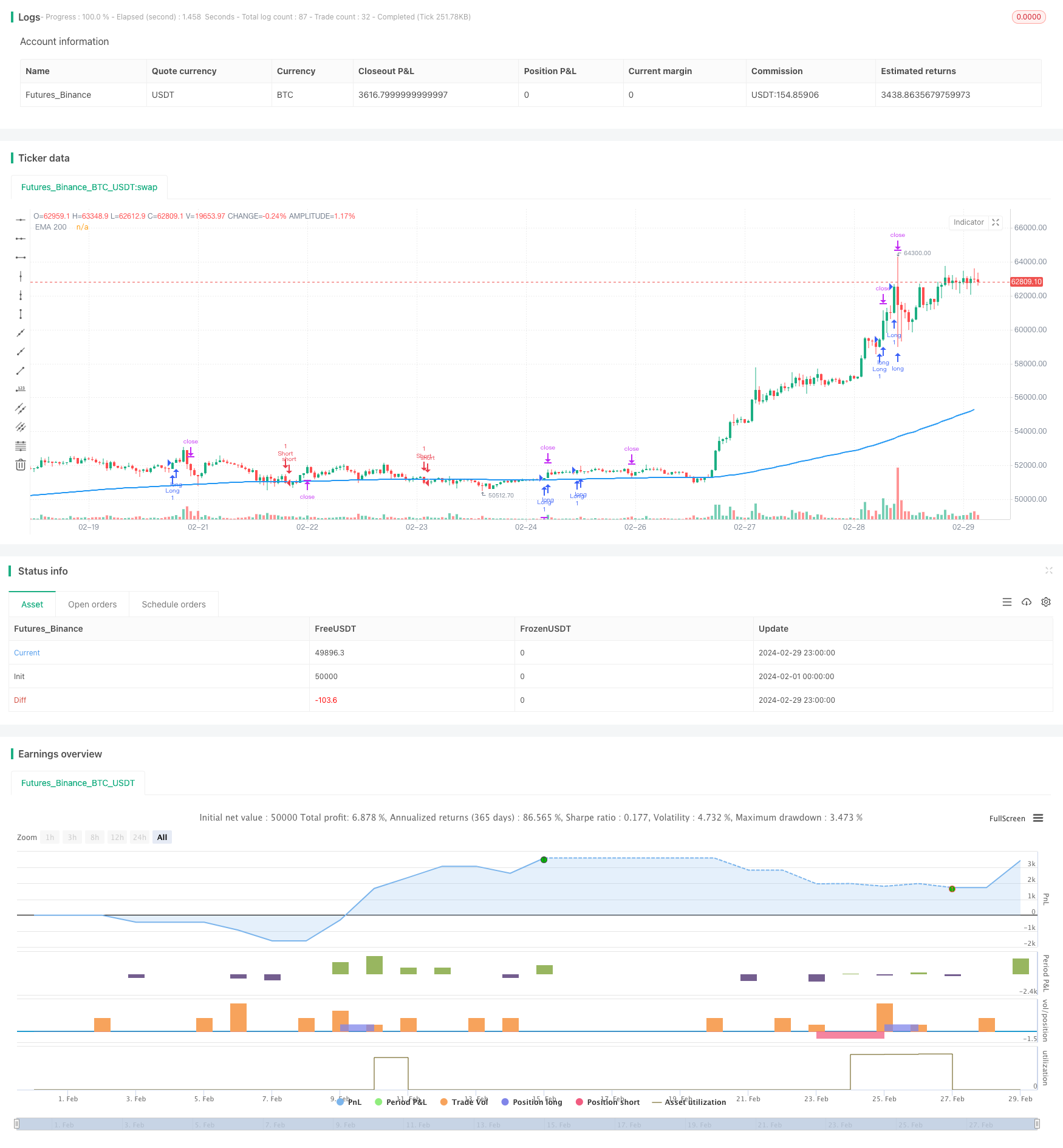
概述
该策略是一个趋势跟随可变仓位网格策略,主要利用EMA、RSI和吞没形态来判断趋势方向和入场时机。策略根据吞没形态的实体大小来调整止损和止盈位置,同时允许用户选择只做多、只做空或者多空都做。此外,该策略还提供了MACD作为趋势过滤条件的选项。
策略原理
该策略使用200周期EMA线来判断大趋势方向,当价格在EMA上方时认为处于上升趋势,在EMA下方则认为处于下降趋势。9周期RSI用于判断动量,RSI大于50认为多头动能较强,小于50则认为空头动能较强。同时,策略使用看涨和看跌吞没形态作为入场信号。当EMA、RSI、吞没形态信号一致时,策略开仓。
策略止损和止盈的位置根据吞没形态实体的大小来确定。止损位置为吞没实体的两倍,同时设置最小止损幅度为入场价的0.3%,以避免止损距离过小导致频繁止损。止盈位置为止损幅度乘以事先设定的盈亏比,确保盈亏比固定。此外,策略提供了MACD作为趋势过滤条件的选项,当MACD主线在信号线上方时认为多头趋势较强,反之认为空头趋势较强。
策略优势
趋势跟随:策略利用多个指标共同判断趋势,有助于在趋势形成初期介入,捕捉趋势行情。
动态止损止盈:根据吞没形态实体大小来调整止损止盈位置,在趋势较强时拉大止盈空间,趋势较弱时缩小止损范围,灵活控制仓位。
用户可自定义交易方向、风险偏好等参数,适应不同用户需求。
提供MACD作为趋势过滤条件的选项,进一步确认趋势强度,提高入场胜率。
策略风险
趋势判断错误:虽然策略采用了多个指标联合判断,但在某些情况下仍可能出现趋势判断错误,导致损失。
幅度收窄:若吞没形态实体较小,止损和止盈距离会非常接近,导致盈亏比恶化,这种情况在震荡行情中较为常见。
参数优化:不同标的、不同周期下,最优参数可能差异较大,需要用户不断调试和优化。
策略优化方向
趋势判断:可尝试引入更多趋势确认工具如布林带、平均方向指数(ADX)等,提高趋势判断准确性。
止损止盈优化:考虑引入ATR等与波动率相关的指标,动态调整止损止盈距离,减少幅度过小带来的风险。
仓位管理:根据趋势强弱、账户盈利情况等动态调整仓位大小,在趋势强且稳定盈利时加大仓位,降低频繁交易带来的成本。
多周期、多品种协同:跨周期、跨品种验证趋势信号,提高趋势把握的胜率,同时分散单一标的或周期的风险。
总结
该趋势跟随可变仓位网格策略在趋势行情中表现较好,通过多个指标共同判断趋势方向和强度,动态调整止损止盈和仓位,能较好地把握趋势,获得超额收益。但在趋势不明朗或频繁波动的行情中,该策略表现一般。因此,在使用该策略时,需要重点关注趋势品种的筛选,并随行情变化调整参数。此外,趋势判断、止损止盈、仓位管理、多周期多品种协同等方面还有进一步优化的空间。
/*backtest
start: 2024-02-01 00:00:00
end: 2024-02-29 23:59:59
period: 1h
basePeriod: 15m
exchanges: [{"eid":"Futures_Binance","currency":"BTC_USDT"}]
*/
// This Pine Script™ code is subject to the terms of the Mozilla Public License 2.0 at https://mozilla.org/MPL/2.0/
// © niosupetranmartinez
//@version=5
strategy("Trend Follower Scalping Strategy", overlay=true, process_orders_on_close = true)
// Inputs
emaLen = input(200, 'EMA Length')
rsiLen = input(9, 'RSI Length')
trendDirection = input.string("Both", 'Trend Direction', options=["Long Only", "Short Only", "Both"])
risk_reward_ratio = input(2, 'Risk Reward Ratio')
useMacdFilter = input.bool(true, "Use MACD Filter")
macdTimeframe = input("5", "MACD Timeframe")
// EMA and RSI
ema200 = ta.ema(close, emaLen)
customRsi = ta.rsi(close, rsiLen)
// MACD Filter
[macdLine, signalLine, _] = request.security(syminfo.tickerid, macdTimeframe, ta.macd(close, 12, 26, 9))
// Majority Body Candle Identification Function
isMajorityBodyCandle(candleOpen, candleClose, high, low) =>
bodySize = math.abs(candleClose - candleOpen)
fullSize = high - low
bodySize / fullSize > 0.6
// Engulfing Patterns
isBullishEngulfing = close > open and close[1] < open[1] and (close - open) > (open[1] - close[1]) and isMajorityBodyCandle(open, close, high, low)
isBearishEngulfing = close < open and close[1] > open[1] and (open - close) > (close[1] - open[1]) and isMajorityBodyCandle(open, close, high, low)
// Entry Conditions with MACD Filter
longCondition = close > ema200 and customRsi > 50 and isBullishEngulfing and (not useMacdFilter or macdLine > signalLine)
shortCondition = close < ema200 and customRsi < 50 and isBearishEngulfing and (not useMacdFilter or macdLine < signalLine)
// Trade Execution
var float stopLossPrice = na
var float entryPrice = na
// Long Entry
if (longCondition and (trendDirection == "Long Only" or trendDirection == "Both"))
entryPrice := close
engulfingBodySize = math.abs(close - open)
minimumStopLoss = entryPrice * 0.997
calculatedStopLoss = entryPrice - (engulfingBodySize * 2)
stopLossPrice := calculatedStopLoss < minimumStopLoss ? calculatedStopLoss : minimumStopLoss
risk = entryPrice - stopLossPrice
takeProfitPrice = entryPrice + (risk_reward_ratio * risk)
strategy.entry("Long", strategy.long)
strategy.exit("Exit Long", "Long", stop = stopLossPrice, limit = takeProfitPrice)
// Short Entry
if (shortCondition and (trendDirection == "Short Only" or trendDirection == "Both"))
entryPrice := close
engulfingBodySize = math.abs(open - close)
minimumStopLoss = entryPrice * 1.003
calculatedStopLoss = entryPrice + (engulfingBodySize * 2)
stopLossPrice := calculatedStopLoss > minimumStopLoss ? calculatedStopLoss : minimumStopLoss
risk = stopLossPrice - entryPrice
takeProfitPrice = entryPrice - (risk_reward_ratio * risk)
strategy.entry("Short", strategy.short)
strategy.exit("Exit Short", "Short", stop = stopLossPrice, limit = takeProfitPrice)
// Plotting
plot(ema200, color=color.blue, linewidth=2, title="EMA 200")